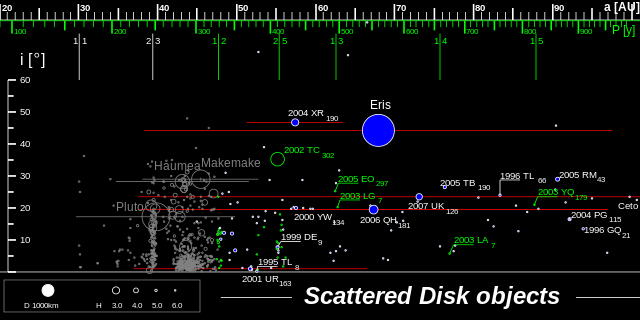
File:TheKuiperBelt 100AU SDO.svg

| |
This is a file from the Wikimedia Commons. Information from its description page there is shown below.
Commons is a freely licensed media file repository. You can help. |
Summary
Scattered Disk Objects (up to 100 AU). Kuiper Belt shown in grey, resonant objects within the Scattered Disk shown in green.
The position of an object represents
- its orbit’s semi-major axis a in AU and the orbital period in years (horizontal axis)
- its orbit’s inclination i in degrees (vertical axis).
The size of the circle illustrates the object’s size relative to others. For a few large objects, the diameter drawn represents the best current estimates. For all others, the circles represent the absolute magnitude of the object. The eccentricity of the orbit is shown indirectly by a segment extending from the left (perihelion) to the aphelion to the right. In other words, the segment illustrates the variations of the object's distance from the Sun. Objects with nearly circular orbits will show short segments while highly elliptical orbits will be represented by long segments.
Main resonances with Neptune are marked with vertical bars; 1:1 marks the position of Neptune’s orbit (and its Trojan asteroids), 2:3 marks the orbit of Pluto (and plutinos) etc.
Data source
Minor Planet Centre Orbit database (MPCORB) as of 2008-10-05. Orbits' classification from MPEC Circular 2008-S05 (2008-10-01) or from MPCORB. Diameter estimates include Stansberry et al. (Spitzer). See refs in the related articles.
| Description | Distribution of Scattered Disk objects. |
| Date | 27 Feb 2006; updated 19 Oct 2008 |
| Source | Plotted by a program written by the User:Eurocommuter |
| Author | User:Eurocommuter |
| Permission ( Reusing this file) |
see Licence tag |
Licensing
|
File usage
Metadata
Wikipedia for Schools...
Through Schools Wikipedia, SOS Children's Villages has brought learning to children around the world. Our 500 Children's Villages provide a home for thousands of vulnerable children. Beyond our Villages, we support communities, helping local people establish better schools and delivering effective medical care to vulnerable children. Have you heard about child sponsorship? Visit our web site to find out.

